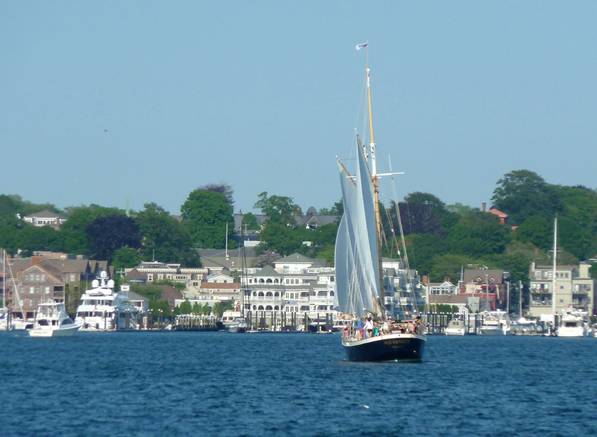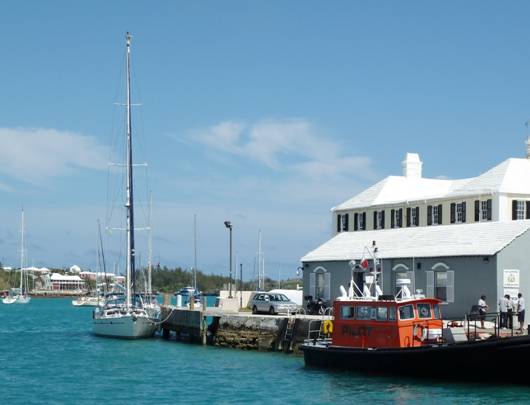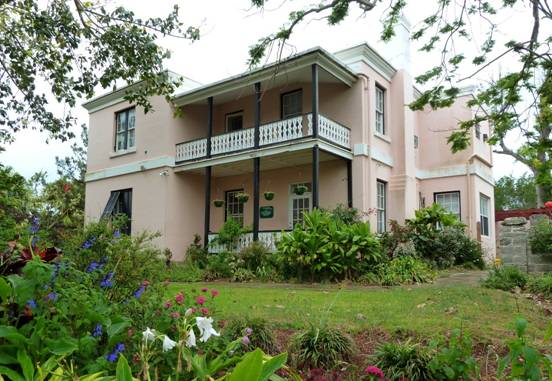Location: 18 30.13 N 64 21.77 W
Ooo la la! We could hardly believe our eyes.
In many ways, 'Ananda' is our very own 'Tardis'. Rather like Dr Who's quirky spaceship, she's quite roomy for just the 2 of us. Comme dites les Francais, 'L'interieur, c'est beaucoup plus grand que l'exterieur'. But this time, after just one day's brisk day's sailing north from St Lucia, it really did feel as though we had been transported through both space and time.
Our arrival on the island of Martinique was greeted by Gallic scenes that placed us firmly back in the heart of Europe, and strolling along the Champs Elysee. We sipped an orangina at a pavement cafe whilst ladies, decked out in the latest Parisian fashions, paraded past boutiques and art galleries. The smell of fresh croissants wafted from the doors of boulangeries and patisseries. All that was needed to complete the scene was an onion-seller in a blue and white stripey t-shirt!
Even the customs and immigration procedures had been bought up to date. We had grown accustomed to the usual island tedious form filling bureaucracy, a natural inheritance from a largely British colonial past and administered by bored officials dragging it out ad infinitum to justify their existence. But here on Martinique, the digital age had dawned. Procedures are rapidly completed by simply filling out an on-line form on a computer housed in a chandlery! And no charge, either. Civilisation indeed.
All this relative affluence is because the island is still effectively administered from France as a quartier. Historically, Empress Josephine grew up here, on a 200 acre, 150 slave estate. And rather cheekily, in 1804 the British captured Diamond Rock, a steep pinnacle off the south coast of Martinique, and commissioned it as a ship. This meant they could take pot-shots at any approaching French ships – a rather nasty surprise for them. Napoleon was incensed – all this and at the home of his beloved Josephine, too! He ordered Admiral Villeneuve to go and re-capture the rock and, whilst he was at it, to destroy Horatio Nelson. Villeneuve did indeed manage to recapture the rock – based on faulty intelligence, Nelson had gone on a wild goose chase to Trinidad. But Villeneuve was in disgrace for not destroying the British fleet, and preferring death to dishonour, he later put his ill prepared fleet to sea to meet Nelson at Trafalgar. Ironically, he survived though Nelson didn't.
The next day, we move from the capital, Fort de France, to Anse Mitan, a quieter anchorage in the same enormous natural harbour with a fort on its headland, now overgrown by nature.
In contrast to Martinique, Dominica is undeveloped and poor, though with a natural beauty. The water was deep right to the land's edge, and we rented a mooring for the night from Dwayne, a friendly and polite boat boy - a real ambassador for Dominica, said Stella – and handed over $30 EC with a bottle of beer for good measure. The following morning we were awoken by an angry fisherman. 'What are you doing on my mooring, man?' Oh dear, just going…
By now we were running out of croissants and ready for another taste of France. So the next stop on our lightening Caribbean tour was the Isles des Saintes, off Guadeloupe. Funny thing, the descriptions at the museum in Fort Napoleon (facing Fort Josephine on the opposite hillside – now sadly in ruins) are not very complimentary about the English! We savour the lovely holiday atmosphere, and enjoy our stay.
But we are awoken at 1am by a huge bang. A 35 foot yacht, Saudade has dragged its anchor and crashed into us. By torchlight there is some damage to our hull and wooden toerail. The French couple onboard are clueless, doing little to help, and make no apology. Furthermore, the captain, a Monsieur Francois Marie Joseph de la Vigne Sainte-Suzanne, is drunk; de la Vigne both by name and by deed. Ignoring our shouts, he motors off into the darkness. Hurriedly, we launch the dinghy and give chase in the dark. By now he is halfway across the bay, but we catch hold of his dinghy and demand that he stops. He refuses and carries on motoring with us in tow, refusing our demands for insurance details. Eventually his wife relents and gives us a business card (a rum factory on Martinique) though still no insurance details. Frustrated, we cast off our dinghy into a moonless night on quite big seas to search for our own yacht, by now miles away and in another bay.
I hope you're reading this, M de la Vigne…
It's a windy sail to Guadeloupe, and 40 knot squalls take their toll on the bimini cover, which needs repairing. But Deshaies is a lovely anchorage, with a beautiful river flowing into the bay. With wet weather, we attend to jobs and I service the generator. Then we walk and climb through the rainforest and up the riverbed for miles, bathing in the rock pools to cool off. Bats fly to and fro across the water, and we have it all to ourselves.
 |
| The beautiful river at Deshaies in Guadeloupe - a great climb through the rockpools |
Guadeloupe is unspoilt, beautiful and civilised. We even have croissants delivered to the boat for breakfast – merci, Harold! – and enjoy them very early the next day watching the Royal wedding live in the surreal environment of a yacht at anchor in this remote tropical bay!
After the Royal kiss on the balcony, on comes the windlass and we're off to Antigua to catch the end of Race Week and sailing at over 9 knots. Things are really humming here, the mood is festive and anchored in Nelson's Dockyard, we can admire the world's finest yachts, both here and in nearby Falmouth harbour.
 |
| Valsheda, a perfectly restored J-class yacht moored next to her support ship Bystander |
Windrose of Amsterdam looks magnificent, and both
Lady B and
Eros are there too. But by far and away the most impressive sight was the arrival of
Maltese Falcon. Huge, stylish and distinctive, she certainly turns heads with her rotating clipper rig - square sails set on 3 giant carbon fibre masts. Built originally for Tom Perkins, the Silicon Valley tycoon and venture capitalist, she was sold in July 2009 for a reputed £60M.
 |
| The magnificent Maltese Falcon |
As she completed mooring up, we walked alongside.
'Nice boat!' I shouted up to the blonde lady standing on the side deck.
In retrospect, I suppose that calling a 289 foot ship, one of the largest privately owned sailing yachts in the world, a 'boat' was not my most sensible choice of words, and so the new lady owner of Maltese Falcon, Elena Ambrosiadou, was certainly entitled to give me the look of disdain that I received.
 |
| On parade in English harbour |
 |
| This yacht, moored in English Harbour, has obviously been well fitted out with jungle cruising in mind. |
The sail to
St Maarten, an island that is half Dutch and half French, was a night passage, and the tone for the journey was set by two large whales, at least 30 feet long, that surfaced about 60 feet off our starboard bow, their waterspouts blowing high into the air.
We passed St Barts in darkness to anchor in Philipsburg at 6am. Later that day, we sailed to Simpson's Bay, a haven for yachtsmen where you can buy or fix almost anything. Here, it's a matter of pride for superyacht owners to take their craft through a narrow passage with a lifting bridge into a huge natural lagoon. Moored up in there was Mirabella V, the largest sloop in the world. It's hard to get a perspective on her lofty mast, the biggest ever built at twice the height of Nelson's column, and we enjoyed supper at a waterside restaurant seated under her stern.
 |
| View of St Maarten from Fort Louis. The mast on the horizon, right side, belongs to Mirabella. Saba, rising to 3000 feet, can be seen in the distance. |
Dinghies are the most convenient form of transport in the lagoon. We zoomed around from chandlery to chandlery, stocking up with spares and motored over to the French quarter to soak up the different culture.
Next stop was the British Virgin Islands. With a night time arrival we navigated carefully through Virgin Sound, the appropriately named passage between Richard Branson's Necker Island and Virgin Gorda, to anchor in North Sound, a large and protected natural harbour. A hired 4-wheel drive car enabled us to explore the island further with its steep roads.
 |
| Richard Branson's yacht Necker Belle. The phone box off the starboard bow isn't much help in keeping him in touch with his business interests, now that it's been converted into a shower! |
 |
| Stellie sews a new 'soft door' for Ananda's companionway |
We're now heading north faster than the sun. Come a favourable forecast, we'll soon be heading off to Bermuda, some 850 miles to the north of the Virgins.
And at this rate, we'll need to start wearing some warmer clothes.













